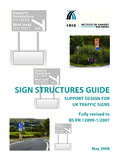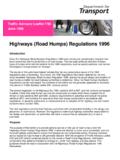Transcription of TRAFFIC ADVISORY LEAFLET X/06 - UK Road S
1 TRAFFIC ADVISORY LEAFLET 9/94 December 1994 Horizontal Deflections Introduction Although horizontal deflections have been used as an alternative to vertical deflections in some TRAFFIC calming schemes, results have been mixed. Little research had been undertaken on this subject in the UK, so designs have tended to be based on details obtained from work in other countries. Such designs do not always translate well from one country to another, because of differing conditions. This LEAFLET summarises the information currently available, including results from the track trials carried out by the Transport Research Laboratory. Doubts which existed over the legality of some TRAFFIC calming devices were removed by amendments to the Highways Act 1980 made by the TRAFFIC Calming Act 1992. This allowed the Secretary of State to make regulations giving clear legal authority to construct a wide range of horizontal deflection features.
2 These include build outs, pinch points, chicanes, islands and overrun areas. Any measures not covered by the regulations can be considered for special authorisation. Speed control Horizontal deflections have mainly been installed to influence vehicle speeds, though not always successfully. In the case of build outs and pinch points the narrowed carriageway, even if reduced to a single lane, still allows most vehicles to be driven relatively quickly through the available gap, unless there is opposing TRAFFIC to prevent this. Unfortunately, in many residential streets TRAFFIC is either tidal, or of such low flow that it is unlikely that vehicles from opposite directions will meet at the narrowing. There is also some evidence that even where there is opposing TRAFFIC , one stream does not willingly give way to the other. Chicanes have been effective in reducing vehicle speeds, as long as large vehicles such as articulated lorries do not have to be accommodated.
3 Where this occurs the stagger length may need to be so long that car drivers can adopt a relatively straight line through the chicane, and therefore speeds are not reduced. Signing horizontal deflections The Highways ( TRAFFIC Calming) Regulations 1993 allow warning signs to be omitted where horizontal deflections are used in 20mph zones. Even in these locations, wherever the carriageway is narrowed to a single lane, it may be necessary to assign priority to one particular direction. Signing to indicate which TRAFFIC stream has priority has not been consistently applied in the past. However, the TRAFFIC Signs Regulations and General Directions 1994 allow the give way markings (diagr am 100 3) to be used, either on their own, or in conjunction with the priority sign (diagram 615). It should be noted that diagram 615 must be accompanied by the supplementary plate, "Give way to oncoming vehicles" (diagra m ), and the sign to diagram 811 with supplementary plate (diagram ) will need to be erected to face TRAFFIC in the opposite direction.
4 It is suggested that in most TRAFFIC calming schemes it will be sufficient to use markings to diagram 1003 alone. Further signs to diagrams 615 and 811 will generally only be needed where extra emphasis is required. Double give way markings At some locations where pinch points have been installed, give way markings have been placed on both approaches. Apart from the doubtful legality of using give way markings in this way, confusion can arise as to which TRAFFIC stream has priority. It is, therefore, recommended that this arrangement should not normally be used. Improved crossing conditions Build outs and pinch points can be extremely useful in improving crossing conditions for pedestrians. The narrowed carriageway at these points means that pedestrians, particularly children, have less carriageway to cross, and can therefore complete their crossing movement more quickly. An additional improvement is that build outs forming the extremities of sheltered parking areas can be extended beyond the limit of the parking areas can be extended beyond the limit of the parked vehicles: as a result, pedestrians are not hidden by parked vehicles and can see and be seen by approaching drivers before starting to cross.
5 Tactile surfaces should be provided to indicate the edge of the build outs, as recommended in Disability Unit Circular 1/91. Chicanes are not generally appropriate at locations where crossing activities take place, as drivers may be concentrating more on how to manoeuvre through the feature than on approaching pedestrians. Beginning of a road hump scheme Give way markings to diagram 1003 are one of the options for the speed reducing feature required by the Highways (Road Humps) Regulations 1990 at the commencement of road hump schemes. So narrowings combined with the give way markings can now be used at the start of a series of road humps. Give way markings in advance of a lone road hump which is sited within single narrowing could not comply, as the give way markings would only be on one approach. Designers will need to be satisfied that the type and geometry of narrowings or other horizontal deflection used would reduce speeds sufficiently on the approach to the first road hump, so that 85th percentile speeds at this location generally will not exceed 30mph.
6 It might also be appropriate to consider the use of the priority sign (diagram 615) at these locations. Road hump warning signs in accordance with the Highways (Road Humps) Regulations would also be required in advance of the first road hump, except in 20mph zone. Consultation Track trials Information on the design of horizontal deflections is available from other countries, and the Transport Research Laboratory (TRL) have translated the Dutch 30 KPH Zone Design Manual. However, to ensure compatibility with conditions in this country the Department of Transport (DOT) commissioned the TRL to carry out track trials to ascertain suitable design criteria for horizontal deflections, and in particular chicanes. The results of the track trials are summarised here. They have still to be substantiated by on-road trials. The parameters investigated were: Stagger length (L) (the length between the start of the stagger on the offside and the finish of the stagger on the nearside, or vice versa, for a one way approach.)
7 Increasing the stagger length increased mean speeds. Short stagger lengths prevented the passage of large vehicles such as articulated vehicles. Lane width (B) (the width of the approach lane.) There was little effect on speeds when the approach lane widths were varied. The trials indicated that drivers were prepared to remain behind cyclists where it was obvious that there was insufficient space to overtake. Free view width (A) (the offset between the offside kerb and the nearside kerb as viewed through the stagger, on a one way approach). Changing the free view width from +1m to -1m reduced mean speeds by about 10mph. Visual restriction (obscuring forward visibility across the buildouts.) This had a positive effect in reducing speeds by 2mph to 4mph. To avoid compromising the safety of children, any barrier provided for this purpose should not be higher than 600mm. Although in the trials the barrier was built up to the carriageway edge, it will normally be preferable to provide a clearance between the barrier and the carriageway edge to avoid the barrier being struck.
8 Reductions in speed may then be less. Double chicanes resulted in mean speeds being 5mph lower than those through single chicanes. Chicane dimensions that were suitable for reducing the mean speed of cars to around 20mph reduced the speed of buses and coaches to about 10mph. They were however too tight to allow an articulated lorry to pass. The trial showed that installing speed cushions on the approach to a chicane would partially compensate for longer stagger lengths required to accommodate large vehicles, while keeping the speed of cars to around 20mph. The use of overrun areas to confine cars to a tighter path but allow larger vehicles to occupy the full width may also be appropriate in these larger chicanes, but this needs investigation. Design dimensions for chicanes, obtained from the track trials using cars, are described in Table 1. However, where larger vehicles need to be accommodated considerable changes would be necessary, as shown in Table 2.
9 This table shows the minimum stagger length that allows large vehicles to pass through at very low speeds (about 5mph). Figures in both tables have still to be assessed against actual on-road conditions. Appearance As far as residential are concerned, the appearance of calming measures is very important. Using temporary materials initially to construct chicanes can prejudice acceptance of the proposals where the finish is unattractive. Careful attention should be paid to the choice of materials, whether temporary or permanent. Advice from conservation officers, landscape architects, etc, may help to produce more acceptable designs. If the temporary materials chosen are likely to be completely different from those of the permanent scheme, this needs to be explained, and a clear indication given of when the permanent scheme is likely to be installed. It may be helpful if residents can be given some impression of the permanent scheme by reference to similar schemes elsewhere.
10 Planters If planters are used they must be adequately maintained. Allowing planters to become overgrown can invite complaints, apart from affecting visibility. If plants are vandalised and not replaced, or allowed to die through lack of maintenance, this will also result in complaints and may prejudice acceptance of the scheme. Normally planters should not be more than 600mm high. Visibility Where a single lane priority system is used at narrowings (pinch point or chicane), the planting or other features should not prevent drivers approaching in opposite directions from being able to see each other. Cyclists There are indications that drivers will not attempt to overtake cyclists where the carriageway width is or less. However, vehicles following closely can be very inhibiting to cyclists. Because of this and the possible danger if a vehicle attempts to overtake, it will often be preferable if a cycle lane can be provided around the deflection, or cyclists can be diverted onto an adjacent cycle track, so they can avoid passing through the deflection.
















